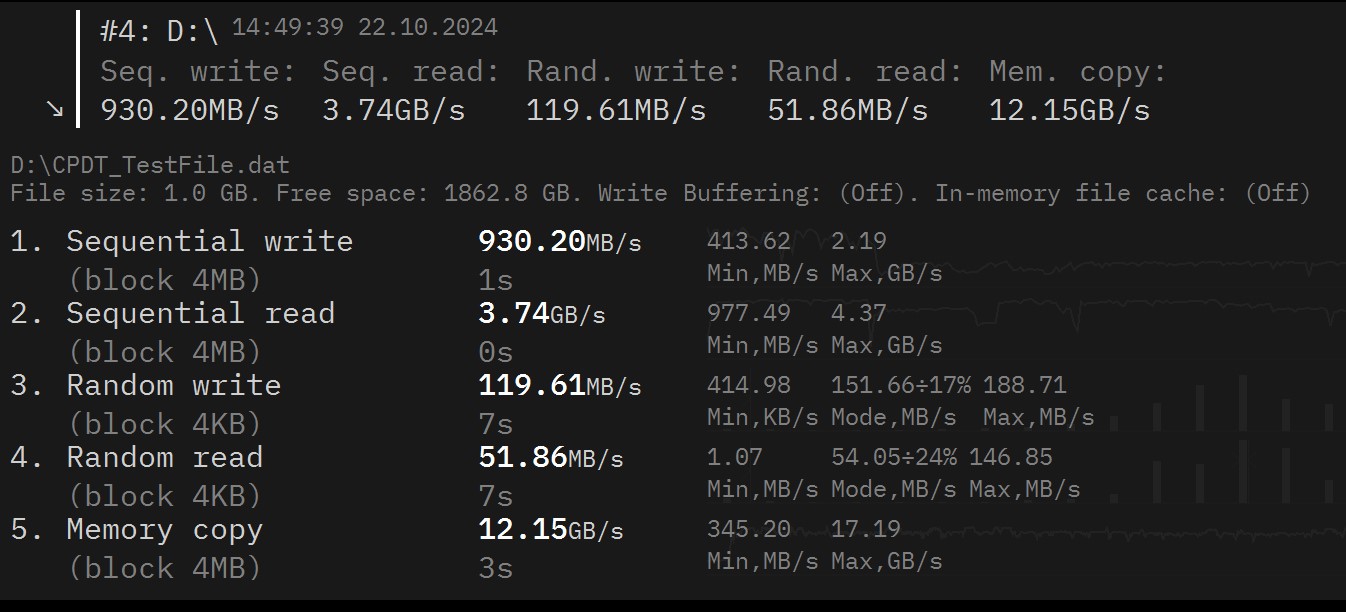The Kingston NV3 PCIe 4.0 Gen 4X4 NVMe SSD is capable of over 6000/5000MBps sequential read/write speeds and comes in 500GB, 1, 2 and 4TB.
It is slightly slower than the Kingston KC3000 PCIe 4.0 NVMe SSD is flaming fast with a graphite heatsink capable of 7000/3900MBps.
The Kingston NV3 PCIe focuses on low-energy consumption and is about 10-15% lower cost.
We stopped testing SSDs at Gen 3 because we didn’t have a PCIe Gen 4 computer. Intel came to the rescue with a high speced Intel NUC 12 Enthusiast i7-12700H, ARC A770M/16GDDR6 graphics, 2 x Thunderbolt 4 and much more. It is a damned shame that Intel won’t be continuing the NUC range, instead working with ASUS and other PC makers to produce a range of small form factor NUCs.
Australian Review: Kingston NV3 PCIe 4.0 NVMe SSD
| Website | Product Page |
| Price (plus freight from Scorptec) | 500GB $69 or 14 cents per GB 1TB $105 or 11 cents per GB 2TB $199 or 10 cents per GB 4TB TBA but around $530 |
| From | Amazon AU and specialist PC retailers |
| Warranty | 3 Years Limited Warranty (based on Terabytes written) 500GB 160TB 1TB 320TB 2TB 640TB 4TB 1280TB |
| In 1987, two engineers and friends, John Tu and David Sun, saw an opportunity in storage technology. | |
| More | CyberShack storage news and reviews |
We use Fail (below expectations), Pass (meets expectations) and Exceed (surpasses expectations or is the class leader) against many of the items below. We occasionally give a Pass(able) rating that is not as good as it should be and a Pass ‘+’ rating to show it is good but does not quite make it to Exceed. You can click on most images for an enlargement.
We are also tightening up on grading. From now on, Pass, for example, means meeting expectations for the price bracket. We consider a Pass mark to be 70+/100, with extra points added for class-leading and excellence. For 2023 reviews and earlier, deduct 10 points from them for reasonable parity.

First Impression – Pass
SSDs are SSDs. Some have gaudy gaming designs and heatsinks and are works of art. This is an M2 2280, single-sided SSD with a sticker over the controller and Nand. It is pretty bland, which is good because it focuses on lower cost and energy efficiency.
As such, it does not try to be the fastest or flashiest. In our tests, its KC3000 bigger brother eats its lunch, usually in the top five Gen 4×4 SSDs. Why? It has both an SLC cache (643GB ‘pseudo’ or virtual cache borrowed from then QLC) and a DDR4 DRAM cache 512MB/512GB, 1GB/1TB, 2GB/2TB, and 4GB/4TB.
This uses Windows HBM (a PCIe pipe to Windows RAM) and around a 500GB SLC pseudo cache to save money yet give reasonable specs. After using it for a week or so, it is perfect for general productivity use. Heavy users moving or rendering large files should use the KC3000.
Finally, it has a ‘variable’ bill of materials. As a volume seller, Kingston uses at least two controllers and two NAND manufacturers to satisfy demand.
You could get it with the SMI SM2268XT2 (usual) or the Phison E27T controller. The flash NAND could be BiCS6 TLC or Kioxia 162-Layer 3D QLC (typical). This is quite normal for a volume product with few performance differences.
Tests
Crystal Disk Mark records the highest read/write rates.

CPDT gives sustained rates and shows the minimum and maximum.

ATTO looks at cache and sustained performance.

The Black Magic Raw Disk test examines the disk’s ability to render different video resolutions.

What does this tell us?
- It exceeds the stated sequential read/write data rate of 6000/5000Mbps
- It slows down fairly quickly when it encounters large files and cache is filled
- It can render 8K@30fps
It is not ideal for larger disk transfers. Once the SLC cache is full (508GB or approximately 15% of remaining capacity), it slows to 200-300MBps versus the KC3000, which has a cache size of 1989MBps.
Energy use – Exceed
It varies from a fraction of a watt to about 3.9W under full load and 70°, making it perfect for extending laptop life. Since it does not have a heat sink, it throttles to keep temperatures in check.
CyberShack’s view – The Kingston NV3 PCIe 4.0 NVMe SSD is a budget line that offers decent cacheless performance.
This is one of the most energy-efficient SSDs we have tested. It is also perfect for typical use – p[productivity, browsing, and even games. There is no stigma with a cacheless drive – it is all about maximum performance for the price.
If you want more, the Kingston K3000 is up there with the best.
Ratings – Kingston NV3 PCIe 4.0 NVMe SSD 2TB as tested
This uses the 2024 rating system, where 70/100 is a pass mark. If you read earlier CyberShack reviews, deduct 10 points for parity.
- Features: 75 – It is a good, solid PCIe 4×4 NVMe SSD
- Value: 85 – Bang for buck is its mantra
- Performance: 75 – Cacheless is fine for typical users
- Ease of Use: 80 – Including Acronis True Image makes upgrades easy. The 3-year warranty is acceptable for this price bracket.
- Design: 80– it is an M2.2280 SSD for laptops and desktops that cannot accommodate a heatsink.
CyberShack Verdict
Kingston NV3 PCIe 4.0 NVMe SSD
500GB From $69













Comments